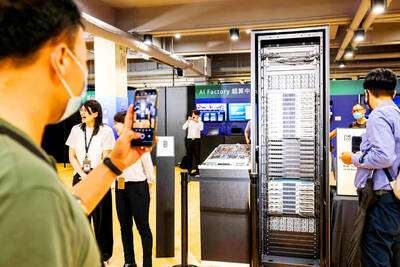Nokia Corp said yesterday that Matsushita Battery would meet all costs related to a warning earlier this month about faulty batteries.
Matsushita said separately that the estimated cost of replacing the batteries would be between ?10 billion and ?20 billion (US$85 million and US$170 million).
Nokia, the world's biggest mobile phone maker, advised customers on Aug. 14 that up to 46 million batteries used in its handsets could pose a risk of overheating. The advisory applied to Nokia BL-5C batteries made by Matsushita Battery Industrial Co between December 2005 and last November at its production facilities in Zhuhai, China.
"Matsushita Battery has agreed to cover the direct costs associated with the product advisory, including, among other things, logistics costs, call center costs, and replacement battery costs," Masatsugu Kondo, president of Matsushita Battery, said in a statement issued by Nokia.
Nokia said that 100 incidents of overheating of the Matsushita-made batteries had been reported worldwide, but that there had been no serious injuries or damage. All cases of overheating occurred during charging, it said.
Nokia did not issue a recall of the batteries but will replace any battery covered by the advisory.
Nokia said it would continue to cooperate with Matsushita.
"We are pleased with the good cooperation between Nokia and Matsushita. Together we aim to serve consumers in the best possible manner and minimize the inconvenience this issue could cause them," said Robert Andersson from Nokia's customer and market operations.
Matsushita is one of several suppliers that have together made some 300 million lithium-ion BL-5C batteries used in 14 Nokia handset models.
Nokia sells products in 130 countries and employs 110,000 people worldwide. In the second quarter, it sold 100 million mobile devices accounting for 37 percent of the global market share, according to technology research group Gartner Inc -- up from 34 percent a year earlier.

LIMITED IMPACT: Investor confidence was likely sustained by its relatively small exposure to the Chinese market, as only less advanced chips are made in Nanjing Taiwan Semiconductor Manufacturing Co (TSMC, 台積電) saw its stock price close steady yesterday in a sign that the loss of the validated end user (VEU) status for its Nanjing, China, fab should have a mild impact on the world’s biggest contract chipmaker financially and technologically. Media reports about the waiver loss sent TSMC down 1.29 percent during the early trading session yesterday, but the stock soon regained strength and ended at NT$1,160, unchanged from Tuesday. Investors’ confidence in TSMC was likely built on its relatively small exposure to the Chinese market, as Chinese customers contributed about 9 percent to TSMC’s revenue last

With this year’s Semicon Taiwan trade show set to kick off on Wednesday, market attention has turned to the mass production of advanced packaging technologies and capacity expansion in Taiwan and the US. With traditional scaling reaching physical limits, heterogeneous integration and packaging technologies have emerged as key solutions. Surging demand for artificial intelligence (AI), high-performance computing (HPC) and high-bandwidth memory (HBM) chips has put technologies such as chip-on-wafer-on-substrate (CoWoS), integrated fan-out (InFO), system on integrated chips (SoIC), 3D IC and fan-out panel-level packaging (FOPLP) at the center of semiconductor innovation, making them a major focus at this year’s trade show, according

DEBUT: The trade show is to feature 17 national pavilions, a new high for the event, including from Canada, Costa Rica, Lithuania, Sweden and Vietnam for the first time The Semicon Taiwan trade show, which opens on Wednesday, is expected to see a new high in the number of exhibitors and visitors from around the world, said its organizer, SEMI, which has described the annual event as the “Olympics of the semiconductor industry.” SEMI, which represents companies in the electronics manufacturing and design supply chain, and touts the annual exhibition as the most influential semiconductor trade show in the world, said more than 1,200 enterprises from 56 countries are to showcase their innovations across more than 4,100 booths, and that the event could attract 100,000 visitors. This year’s event features 17

Hon Hai Precision Industry Co (鴻海精密), which assembles servers for Nvidia Corp, yesterday said that revenue last month rose 10.61 percent year-on-year, driven by strong growth in cloud and networking products amid continued front-loading orders for artificial intelligence (AI) server racks. Consolidated revenue expanded to NT$606.51 billion (US$19.81 billion) last month from NT$548.31 billion a year earlier, marking the highest ever in August, the company said in a statement. On a monthly basis, revenue was down 1.2 percent from NT$613.86 billion. Hon Hai, which is also a major iPhone assembler, added that its electronic components division saw significant revenue growth last month, boosted